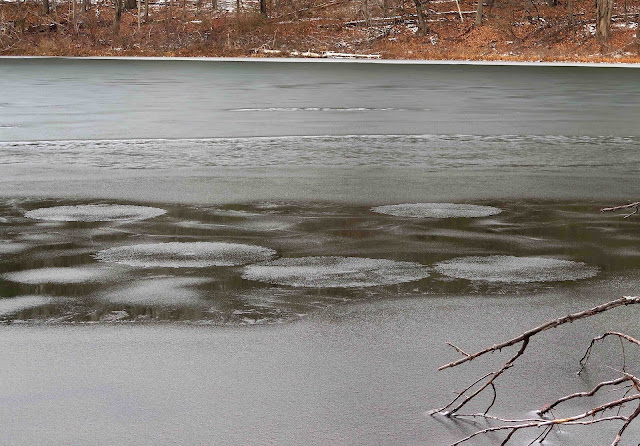It's absolutely gorgeous outdoors today, clear blue sky, little wind, warmish temps, but I have so many tasks to do, I don't have time to get out to enjoy it. And the last time I did get out there, a visit to Moreau Lake late last week, everything was GRAY: lake, sky, mountains, ice. Kinda cold and windy, too. Could I find ANYthing out here to delight me?
Well, I did find these floating disks of slushy ice in a patch of open water kind of fascinating. What could have caused these perfectly circular shapes? At least their existence gave me a puzzle to ponder.
And I did find a few spots of color as I wandered the woods near the shore. I loved how the warm, cinnamon-brown hues of this Stereum fungus contrasted with the icy crystals that adorned it.
And the myriad tiny cones among the braided green twigs of Eastern Red Cedar (Juniperus virginiana) offered not only some attractive color but also a bit of a surprise: Where did this solitary tree come from, the only one of its kind on a long stretch of shore?
Here, too, was another puzzle to ponder: The dark-blue fruits of Maple-leaved Viburnum (Viburnum acerifolium) are so attractive, dangling as they do on such vivid hot-pink pedicels, how come they haven't been devoured already by wildlife? I often find them quite late in winter, shriveled and ignored, still hanging on, uneaten. I wonder why.
It's easy to ID young Sassafras trees, even in winter, after their distinctive mitten-shaped leaves have fallen. Just look around for twigs and buds of such a bright spring-green color the small trees stand out from all the other saplings in the understory.
Striped Maples have especially elegant and colorful twigs and buds this time of year. I did find it cheering to find these understory trees with their colorful buds that hold the promise of spring, even though it's not yet officially winter.
And here was a plant that always delights me, ever since I discovered this extremely rare Whorled Mountain Mint (Pycnanthemum verticillatum var. verticillatum) on the sandy shore of Moreau Lake back in 2013. At that time, the population of this Endangered species thrived by the hundreds here, but years-long high water levels later caused the population to diminish. Last summer, I counted fewer than 20 specimens, trying to make a come-back along the now-dry shore. Thankfully, the plants looked very healthy, even now, with their still-green leaves in December, the flowerheads having spilled the seeds that I'm hoping will re-build the original abundant population.

This last find, of the dry, empty seedpods of Blue Curls (Trichostema dichotomum) was hardly colorful, but I think the husks make up in cuteness for what they lack in color. As thin and translucent as tissue paper, the tiny three-toothed, scoop-shaped cups once held two shiny black seeds nestled within like two babies in one bunting. And of course, their presence on Moreau Lake's sandy shore holds the promise that we will find these beautifully blue wildflowers when we walk here again in late summer.









1 comment:
Too many gray days this time of year. Your floating ice discs were probably created by the wind or current repeatedly pushing floating pieces of ice in a circular manor against the edge of the open water. fruits of maple-leaved viburnum and cranberrybush viburnum, like those of a number of other shrubs, are apparently unpalatable to most birds -- they're usually eaten late n the winter after better-tasting berries have all been eaten.
Post a Comment